Yagit is a (severe!) contraction of Yagi to ookami which is Japanese for goat and wolf.It’s a spatial awareness puzzle played on a square grid divided into cells. The grid represents a field. In some cells are goats, and in others are wolves. Your goal is to erect fences to divide up the field in such a way that goats and wolves never find themselves in the same area. There are some fence posts dotted around the field to help you.
In a hurry? Jump to: Rules / Tips / Worked Example / Video Tutorial / Download Free Puzzles / Books
Here’s what a small Yagit puzzle looks like:
The rules of Yagit are as follows:
This is what the example puzzle looks like once it has been completed:
Yagit is solved through a combination of logical deduction and elimination. There is always a logical solution and never any need to guess, but as puzzles get harder you will need to make longer chains of deduction to work out where fences must be placed. Here are some tips to help you get started, and then we will work through an example puzzle from start to finish.
Begin by separating goats and wolves in adjacent squares. Since they cannot be in the same field, there must be a fence between them. You can extend these fences to the boundaries or fence posts, whichever comes first, because fences cannot exist in isolation.
Eliminate routes from fence posts that already have two lengths of fence attached (because fences cannot cross at posts). This reduces the options for where fences can go.
You can also eliminate routes where placing a fence would create an empty area.
When you eliminate a route (cell dividing line), you can continue to eliminate it in both directions until you reach a border or a fence post.
The best way to understand how a puzzle works is to solve one. We’ll work through an example from start to finish, which will give you a good idea of the basics. Remember, though there is only one valid solution, there are many ways of reaching it. This is not the way to solve this puzzle, just one possible path to do so.
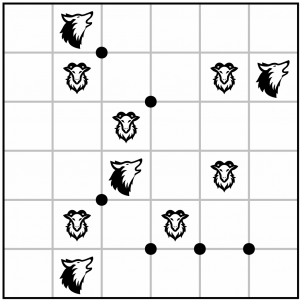
This is the puzzle we are going to solve. It’s an easy Level 1 grid that provides an overview of the basic techniques necessary.
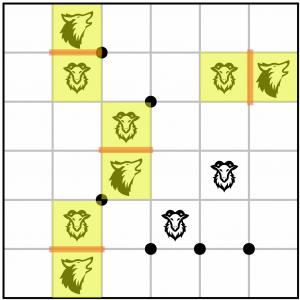
We’ll begin by separating goats and wolves that are in adjacent cells. There are four such cases on this board, so we start by drawing in sections of fence to separate them.
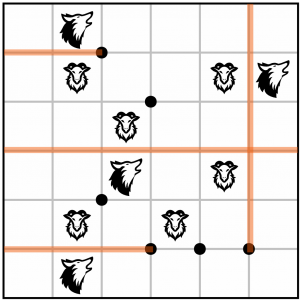
Because we know that fences must originate and terminate at the borders of the field, and that they can only turn at a fence post, we can extend our fence sections to the borders or posts, whichever come first.
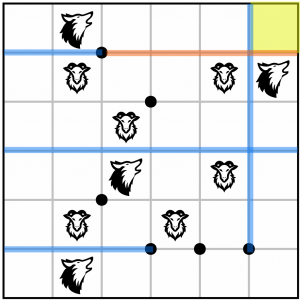
To work out where we must go next, we can start to eliminate some possible routes for fences. Consider the fence at the top left corner. From the fence post, it could turn ninety degrees and go to the top of the field, or it could turn ninety degrees the other way and go to the post three rows further down the field, or it could continue straight on and go to the right-hand edge of the field (as shown here). However, were it to go straight on like that, we would be creating an empty area (yellow) which is not allowed.
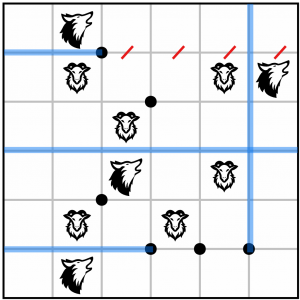
Therefore we know the fence cannot go straight on. That means we can strike through those borders to remind ourselves that no fence can run there. This will help us see options as we progress.
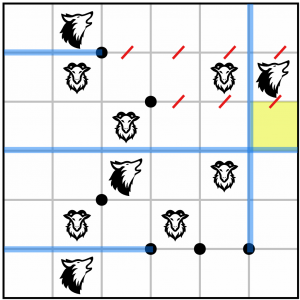
We can also strike through a potential route one row further down for the same reason – any fence to run along it would create an empty area in the yellow highlighted cell.
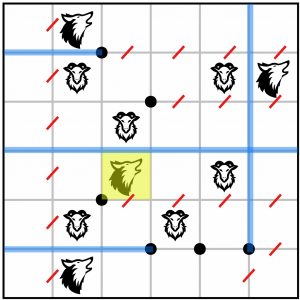
In fact, we can cross off quite a few possible fence routes. All these red strike marks show us where we can’t put a fence because we’d be creating empty areas. This helps us see where we must run fences.
Now, let’s look at the wolf highlighted in yellow. We need to separate it from the two goats to its right. There’s only one place we can possibly put a fence that will do that, so we can draw it in…
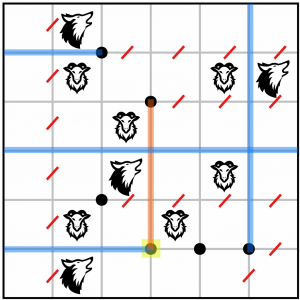
…like this.
This new fence gives us a new clue. Because it’s connected to a fence post that already has a fence attached to it, we know that no more fences can ever connect to that post (because fences cannot cross at posts). That means we can strike off the two remaining paths to that post.
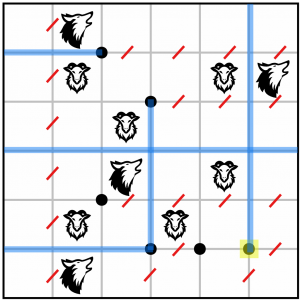
Now consider the (highlighted) fence post in the bottom right corner. It’s only got one possible path it can take – it has to connect to the post to its left.
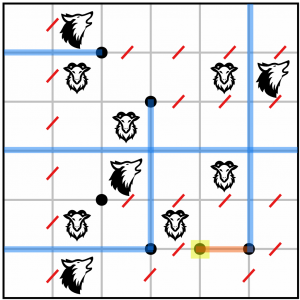
Having drawn it in, it’s easy to see that it must now go upwards. We’ve eliminated the path to the left, and if we were to go down, we would be creating a large empty area. Up to the top of the field is the only route possible…
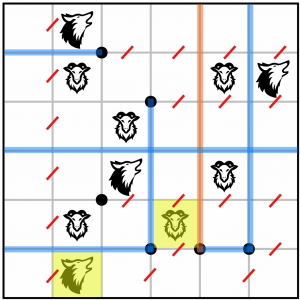
…like this.
We’re making good progress. There are a couple of ways we could continue, but let’s look at the goat and wolf highlighted here. We need to separate them, and there’s only one fence we can put in which will achieve that.
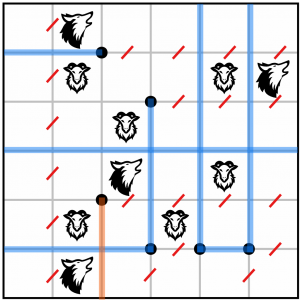
We run the fence from the border up to the first post we encounter. Now we have a choice to make. Do we continue that fence up to the next post above, or do we turn left? See if you can work it out…
Did you do it? To see the answer, let’s consider what would happen if we ran the fence up towards the top of the field.
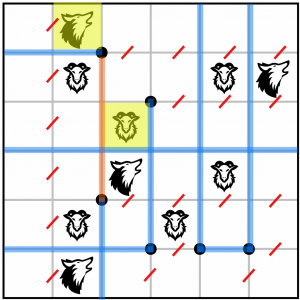
At first glance, it looks like it might work. But we’d still have to separate the two enemies highlighted in yellow, and there would be no way of doing that without creating an empty area – it’s just not possible.
So that means it’s not a valid option. We have to run that fence to the left instead.
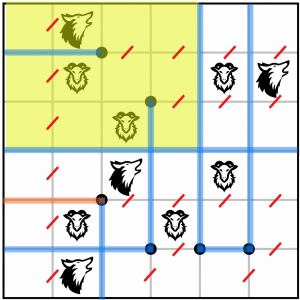
Now we just have the top corner to worry about. There are two fence posts in the yellow box, and each one has two possible directions in which a fence can be run to reach the border or another fence post. You can think through all the permutations, but there’s only one way to complete the two fences that does not leave us with an empty area…
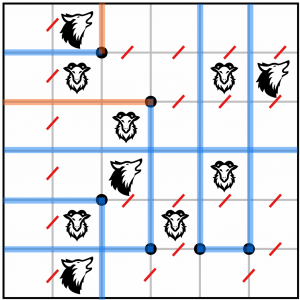
…and this is how it’s done.
That’s it, the puzzle is solved. Every area contains at least one animal, and there are no goats and wolves within the same area. No fences cross at posts. Simple! Ready to try one yourself? Read on…
We’ve put together a taster of four puzzles for you, including the example above. You can download and print the PDF below. Solutions are included, but no cheating!
Finished the taster and want more great Yagit puzzles? No problem! Get 120 carefully crafted puzzles set over seven levels in Puzzle Weekly Presents: Yagit– it's great value!
We include Yagit in Puzzle Weekly from time to time. Puzzle Weekly is our free weekly puzzle magazine – find out more, and get your copy, here.